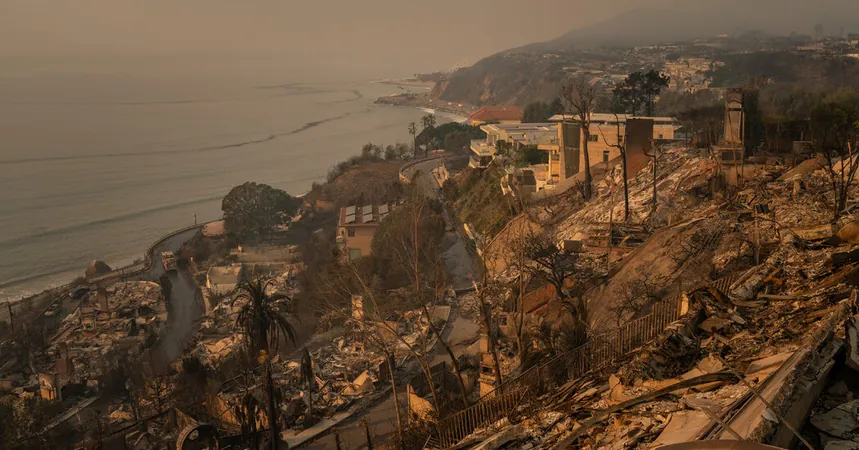
How Los Angeles Wildfires Will Intensify the Housing Crisis: A Looming Disaster
2025-01-09
Author: Lok
The recent series of devastating wildfires in Los Angeles has left thousands in despair, igniting individual catastrophes for every home lost. The aftermath not only highlights personal tragedies but significantly exacerbates the city’s already critical housing shortage.
As of Thursday morning, approximately 180,000 residents are under evacuation orders — a staggering figure that underscores the sweeping impact of the crisis. For many, temporary shelters such as public facilities, the homes of friends and family, or nearby hotels offer refuge, but as the flames continue to ravage the landscape, the true scale of displacement remains unclear.
In the coming weeks, those who have lost their homes will face the pressing challenge of securing stable accommodations amid an already strained market. According to Zillow, as of 2022, Los Angeles had a staggering deficit of around 337,000 homes, with inventory at 26% below pre-pandemic levels. This shortfall highlights a troubling reality: the city was juggling a housing crisis before the fires, and the current situation threatens to amplify it.
Mayor Victor M. Gordo of Pasadena, already grappling with significant losses due to the Eaton fire, emphasized that 'getting people who lost their homes into permanent, long-term housing' will be one of the most daunting challenges ahead. The aftermath of these wildfires and the ensuing displacement will likely worsen the tight rental market, pushing more displaced families into rental units — a prospect coupled with soaring demand.
The median rent for a one-bedroom apartment in Los Angeles has shot past the $2,000 mark, creating an environment ripe for a rental market crisis. Dr. Carles Vergara-Alert, a finance professor at IESE Business School, warns that a surge in demand from displaced residents in a contracting supply will inevitably drive prices upward. The ripple effect could burden all renters in the region, not just those directly affected by the fires.
Jonathan Zasloff, a land use and urban policy expert at UCLA, personally understands this burden as he seeks transitional housing after losing his home in Pacific Palisades. He described the dislocation of his family and acknowledged the broader implications of his situation, suggesting that as displaced families compete for limited rentals, students and other tenants might find themselves pushed out into the already oversaturated market.
Indeed, California has been grappling with an affordable housing crisis for the past decade. Despite recent legislative attempts to streamline housing development and enhance affordability — including Mayor Karen Bass’s executive order for 100% affordable units — progress remains slow. The landscape of housing approvals in Los Angeles hit a 10-year low in 2024, exacerbating fears over a potential building stagnation.
As legal expert Dave Rand noted, 'This is a place that had massive affordability challenges last week, and now, it’s going to be that much more challenging.' Yet there is a flicker of hope amid this tragedy. Rand suggests that the joint effort of community rebuilding could serve as a catalyst for broader reforms in housing policy, specifically in increasing the pace of affordable housing creation.
The city's ambitious goal of developing nearly half a million new units by 2029 faces additional challenges in light of this catastrophe. If too many displaced residents attempt to rebuild simultaneously, the cost of materials and labor could skyrocket. Coupled with the persistent shortage of construction workers — a problem exacerbated in recent years due to the pandemic — the city may find its housing production ambitions hindered.
Andy Howard, a seasoned contractor with three decades of experience in Los Angeles, expressed concerns that these fires would exacerbate existing pressures, driving costs even higher. 'It’s going to make it worse,' he warned, reflecting a sentiment shared by many in the industry.
As Los Angeles navigates the aftermath of these wildfires, the intertwining crises of housing availability, affordability, and displaced families loom larger than ever. The question now is whether this calamity will ultimately catalyze the systemic changes needed to build a more sustainable, equitable housing landscape, or whether it will drown in the very flames of despair it ignited.


 Brasil (PT)
Brasil (PT)
 Canada (EN)
Canada (EN)
 Chile (ES)
Chile (ES)
 Česko (CS)
Česko (CS)
 대한민국 (KO)
대한민국 (KO)
 España (ES)
España (ES)
 France (FR)
France (FR)
 Hong Kong (EN)
Hong Kong (EN)
 Italia (IT)
Italia (IT)
 日本 (JA)
日本 (JA)
 Magyarország (HU)
Magyarország (HU)
 Norge (NO)
Norge (NO)
 Polska (PL)
Polska (PL)
 Schweiz (DE)
Schweiz (DE)
 Singapore (EN)
Singapore (EN)
 Sverige (SV)
Sverige (SV)
 Suomi (FI)
Suomi (FI)
 Türkiye (TR)
Türkiye (TR)
 الإمارات العربية المتحدة (AR)
الإمارات العربية المتحدة (AR)